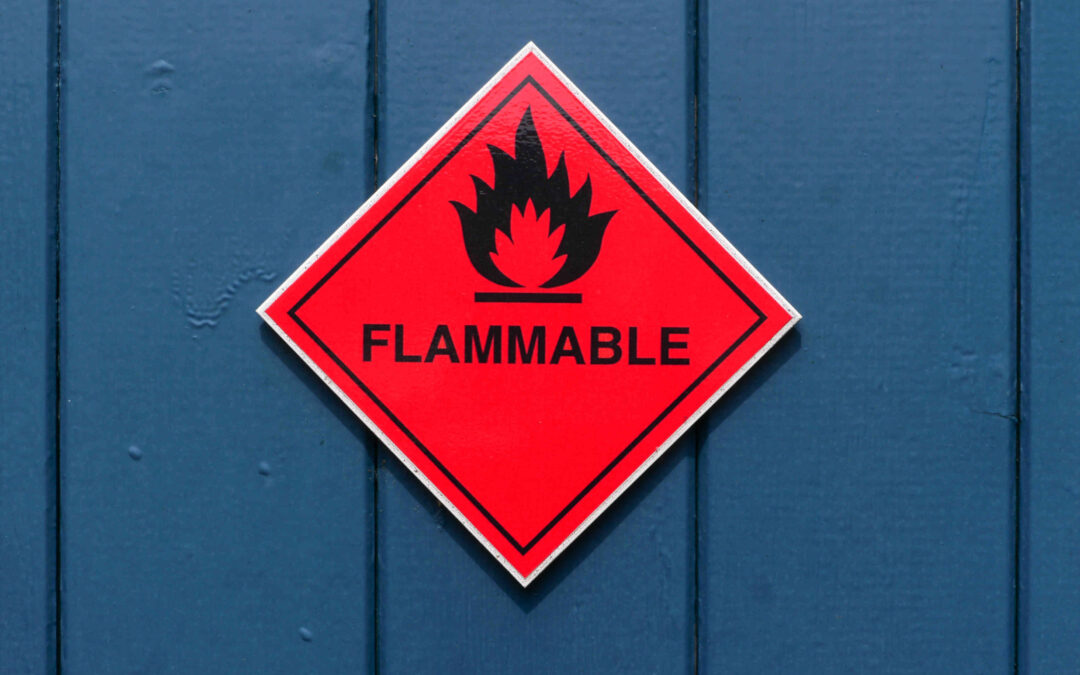The safe manufacture and storage of flammable substances requires compliance with a number of strict rules. What are flammable materials and how should they be manufactured and stored?
Table of contents:
What are flammable materials?
Flammable substances are materials that can ignite and cause a fire when exposed to an external factor, such as heat, spark, or pressure. Flammable materials are ubiquitous. They are used in construction, transport, the manufacture of everyday articles, and other sectors. To safely use flammable materials, one must observe strict safety standards for their storage and handling.
What are the types of flammable materials? The rules for storage of flammable materials depend largely on the flash point of the substance. The first group is made up of materials with a low flash point, which means they are the most hazardous. They ignite below 55°C. They include petrol, ethanol, and butane propane.
The second group is made up of flammable substances with an average flash point between 55 and 100°C. They include diesel, motor oil, and aromatic hydrocarbons. The last group consists of substances with a relatively high flash point, exceeding 100°C. They include paper, aerosols, plastics, and textiles.
Like most substances, flammable materials can be divided according to their physical state, which also greatly affects how they must be stored. Another division is into flammable substances of natural origin and those produced artificially. Moreover, flammable materials often contain various chemicals, such as solvents or dyes, which increase their hazard potential.
Flammable materials are used in many production processes and industries. Production with the use of flammable materials requires not only caution but also knowledge of the regulations and guidelines for their storage and use. The most important regulation is that flammable substances should be stored in designated containers, away from sources of heat or sparks, and that the room in which they are stored should be properly ventilated.
Flammable materials – storage and use
The storage of flammable materials, irrespective of the quantity, involves the risk of fire, which is a great danger to the plant assets and employees. For this reason, it is very important to comply with standards and safety rules for the storage of such substances.
First of all, any fire hazardous materials should be handled in accordance with the fire safety requirements set out in the fire safety manual or in accordance with the requirements set out by the manufacturer of the substance.
In many industries, combustible materials are used in the production process. In the production involving combustible materials, they cannot be stored at the workstation in excess of the daily requirements of the process. Larger quantities must be kept in a separate, dedicated storage room. The storage method must eliminate the risk of fire or explosion arising from the stacking or interaction between combustible materials.
If the flammable material in storage is a liquid with a flash point below 55°C, it has to be stored in specially adapted containers or systems made of flame-retardant materials. The containers should be tightly closed and resistant to easy mechanical damage and should dissipate static charges.
Due to their characteristics, flammable materials cannot be stored in underground storage areas, attics, or lofts, or in publicly accessible areas, such as corridors. Containers of flammable materials should not be exposed to sunlight or placed near heat sources.
Flammable materials – requirements for machinery
According to the Machinery Directive, all machinery intended for use in explosive and flammable environments should meet the requirements of Directive 94/9/EC, also known as the ATEX Directive. It defines the minimum conditions that should be met to ensure safety in potentially explosive workplaces.
A machine should also comply with ATEX if it does not work in potentially explosive conditions, but has one or more components containing flammable and explosive agents. Note that a machine used in a flammable environment should also be equipped with a fire protection system.
Machines should be not only be properly designed for use with flammable materials, but they also have to be kept in proper technical condition. Any malfunction can increase the risk of ignition or explosion so regular inspections should be carried out and any malfunctions found should be immediately rectified.
Flammable materials. Summary
We hope that this article gives you a better idea of what flammable materials are and how they should be stored and used so as to minimise the risk of fire. Flammable substances are used in many production processes so the knowledge of how to handle them safely is used in many workplaces on a daily basis.
What are the basic rules for handling flammable materials? First of all, they should be stored in special containers. In addition, under no circumstances should they be exposed to sunlight or any other source of heat or sparks.
Special requirements also apply to machines using flammable materials in production processes. These machines should comply with the requirements for working in explosive and flammable environments as outlined in ATEX.
You should consider having such machines manufactured by Unilogo. We have many years of experience in building machines for various industries, including those that use flammable substances. If you would like to learn more about our company and the machines we offer, feel free to use the contact form at www.unilogo.com.


